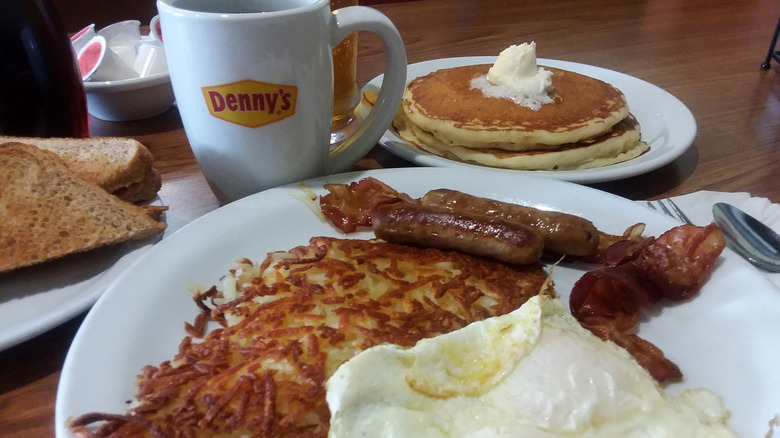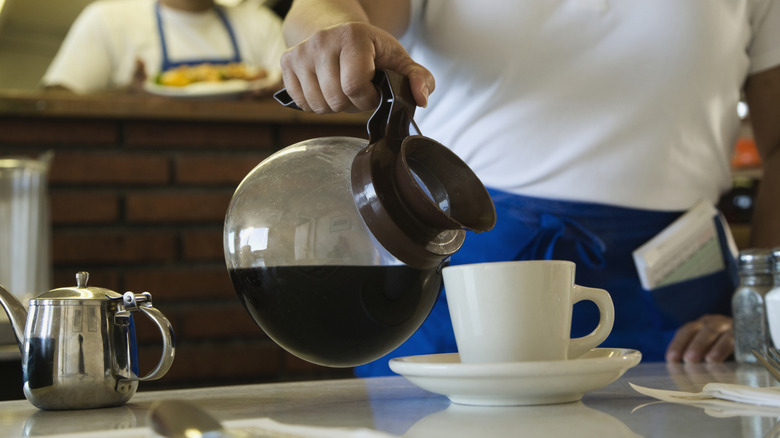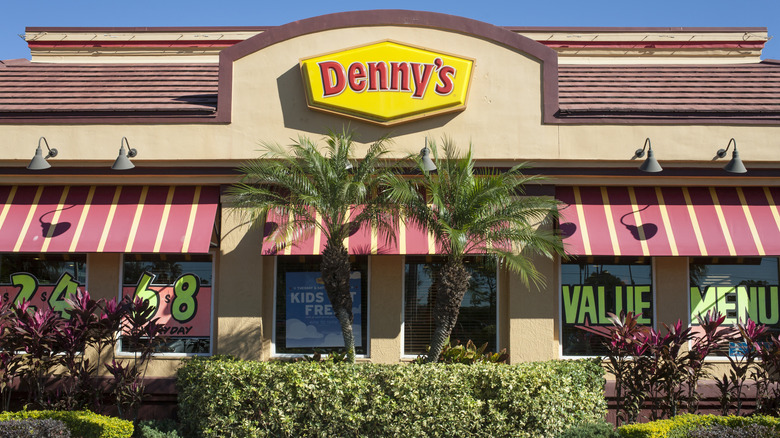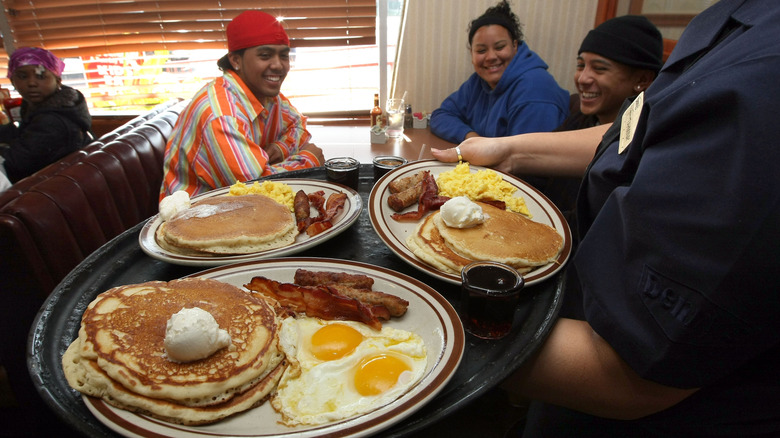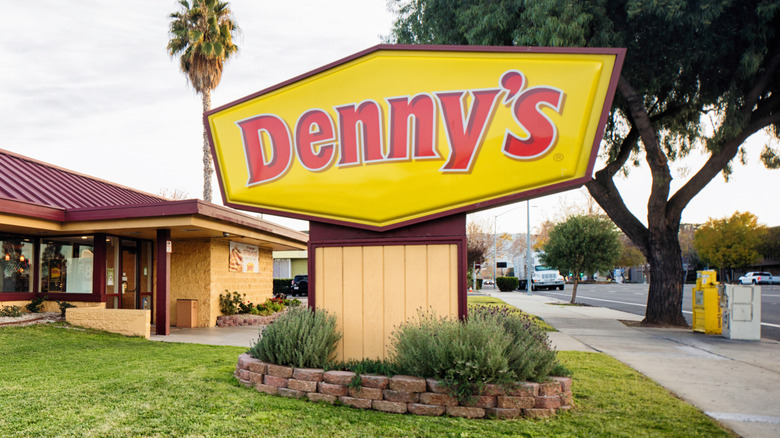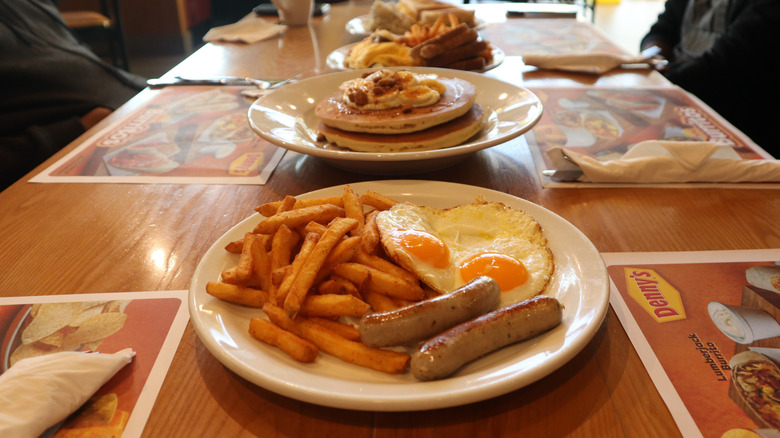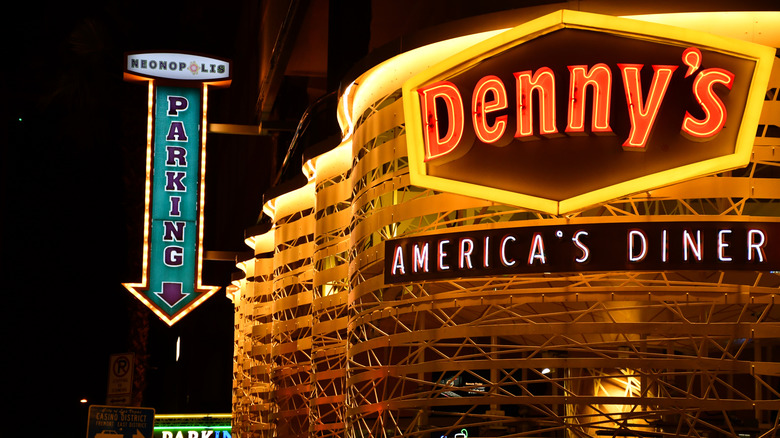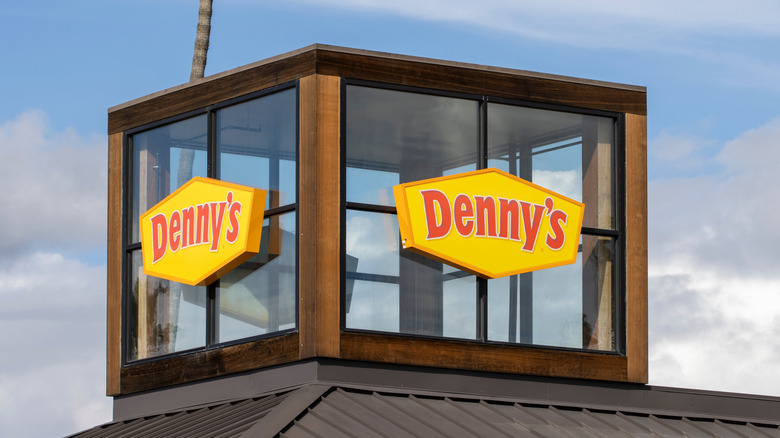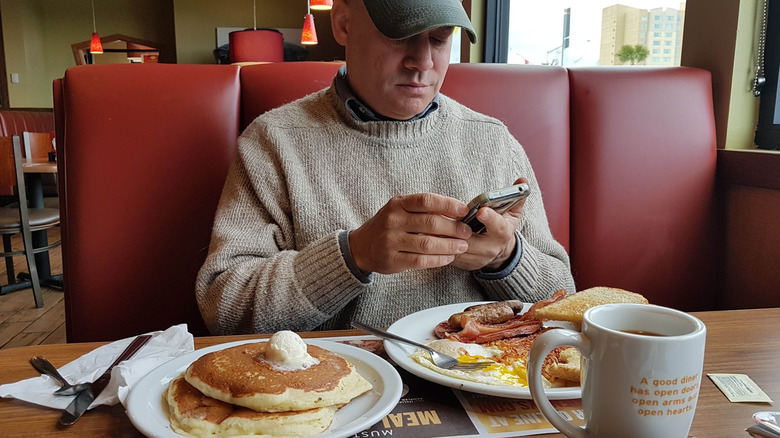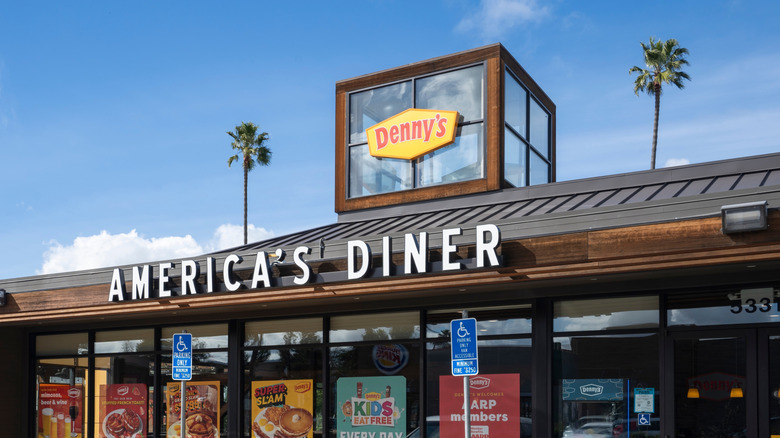The Rise And Fall Of Denny's
There was a moment in history when Denny's was the diner of choice for many hungry Americans, and eventually eaters around the world. The chain seemed to have something for everyone. Cheap diner food you could depend on? Check. 24-hour service for those after-hour cravings? Check. Tacky Naugahyde booths that stuck to the back of your legs? Certainly, somebody liked that, so ... check. After its launch as a local California favorite, Denny's spread its wings and took over the dining scene, drawing anyone who loved the old-fashioned sit-down experience, complete with counter service and unending coffee refills. It was a modern marvel that helped introduce comfort dining to a working class clientele whose lives were changing as quickly as the world they lived in.
Somewhere along the line, the shiny booth seats lost their sheen, the coffee cooled, and dining at Denny's became a thing of the past. Since its descent from the heights of success, Denny's has struggled to find its footing in a modern world where folks order food on their phones and fast casual eat-in restaurants supplanted the classic diner. How did this American classic climb to soaring highs only to fall into the realm of kitsch and comebacks? It's a tale as old as time, a cautionary tale of a beloved charmer pushed aside by shinier newcomers, clawing to keep its place on the commercial dining landscape.
While Denny's may still be alive and kicking, the company has its share of challenges ahead, with even more coming as the shifting trends of the dining industry push a legacy company to find new ways of doing business.
Opened as Danny's Donuts in 1953
Not long after the 20th century reached its midway point, a humble bakery called Danny's Donuts launched in Lakewood, California. The year was 1953, and the menu contained donuts, coffee, and a serving of hospitality that came free with every order. Proprietors Richard Jezak and Harold Butler brought the first location and added several other locations over several years. Neither partner had a particular attachment to the name Danny; it was simply chosen as a clever business move, tapping into its relative popularity at the time. So much for wondering if the real Denny would ever step out behind the curtain to take credit for his namesake restaurant!
Here comes the first twist in the saga: Danny's Donuts, which eventually went on to become Denny's diners, should not be confused with Denny's Donuts, a donut shop currently in operation in Bloomington, Illinois. To make matters even more convoluted, Harold Butler eventually transformed the early concept of Danny's Donuts into Winchell's Donut House, a West Coast confectionery contender that gave Dunkin' a run for its donuts in the 1970s. While there are still plenty of Winchell's locations in operation in California that prove out Butler's concept, Danny's Donuts would quickly evolve a step closer to becoming the Denny's we all know and love (or loved, as the case may be).
The original location became a 24-hour coffee shop, renamed Denny's
Call it a design expansion, a paradigm shift, or simply an accommodation to the local clientele, but in 1956, Danny's Donuts turned into a 24-hour operation to provide refreshments for the round-the-clock workforce operating the Douglas Aircraft factory. This was the first of several lasting features that would eventually turn the burgeoning chain into an anytime diner, giving peckish night owls a place to land for provisions cooked to order. The undeniable convenience and availability helped the original location gain a foothold on the local landscape, fed by a steady flow of locals in need of sustenance at all hours.
The hours of operation weren't the only change made in this era. To prevent confusion between Danny's and Coffee Dan's, another 24-hour coffee shop operation, the name changed to Denny's in 1961. It was all uphill from there, and by 1966, Denny's restaurant count numbered over 100. With a mix of franchises and company-owned locations, the expansion jumped on the new wave of consumers who were too busy to cook and were on the lookout for fast, fresh food to savor. By the end of the 1960s, the number of Denny's locations had reached the 500-plus mark, with growth continuing into the new decade.
Denny's went international and became publicly traded in the late-60s
It wasn't enough for Denny's to conquer America; the chain set its sights on other regions of the world, starting with an Acapulco location opened in 1967. This expansion signaled Denny's intention of bringing American-style diner fare to a global audience. Now Denny's could grow beyond the borders of the U.S., capitalizing on a simple, dependable format that was fast becoming a darling on the domestic dining scene, a trend that would continue well into the new millennium as Denny's reached South America, the Middle East, and Indonesia. Travelers abroad could find familiar favorites while locals could enjoy what America was cooking up.
In 1968, Denny's went public and began trading shares on the New York Stock Exchange. Taking on outside investors helped fuel growth through the years, with the ups and downs of trading leading to an all-time high stock price of $23.61 in 2019. This was the age of upward growth and outward expansion for the chain. The idea of restaurant eating for busy families was catching on, and a wholesome atmosphere offering food that emulated home cooking available around the clock was a concept that consumers ate up with a passion. With new locations added every year, there was still major growth in store for this former coffee shop that had taken the dining world by storm.
The chain introduced its popular Grand Slam Breakfast in 1977
One of Denny's longest-lasting contributions to the world of dining, the Grand Slam Breakfast, was introduced in Atlanta, Georgia in 1977 as a tribute to local MLB superstar Hank Aaron. The order included a round-up of Denny's best items and made them available in a single-priced collection. Now guests could enjoy two each of Denny's buttermilk pancakes, eggs any style, bacon strips, and sausage links all in one generous menu listing instead of having to order everything à la carte. It was like one-stop shopping for the finest in old-fashioned dining, packaged for a new-fashioned audience. The fact that it came with a catchy name made it even easier to spread the word among the dining public.
Though the original Grand Slam currently shows on Denny's website at a whopping $12.99, the 1977 version showed up at an introductory price of $1.99. It was a smash that helped keep Denny's thriving with the dining public while demonstrating the chain's ability to tap into pop culture to create meaningful connections with customers. Even guests who had no idea who Hank Aaron was could benefit from the tie-in. The Grand Slam became so familiar, it led to competitors like IHOP releasing similar catchy-named collections like their Rooty Tooty Fresh 'N Fruity in the 1980s. Regardless of the imitators, Denny's will always be the chain that hit a home run with its heavy-hitting breakfast round-up.
The chain had grown to over 1,000 locations by 1981
Who knew a little diner could grow into a colossal enterprise so quickly? In less than 20 years, Denny's had gone from a small collection of California coffee shops to one of the most familiar restaurants in the U.S. It was easy to find Denny's along interstate routes and highways, giving road trippers and long haul truckers a happy place to land when hunger struck. This was the era when it seemed like there was suddenly a Denny's just about everywhere you looked. The proliferation made it easy to find a sit-down space when fast food felt a little too casual and high dining wasn't on the menu.
Part of Denny's growth in the 1980s came from the financial troubles of another diner chain called Sambo's. After filing for bankruptcy and closing down most of its locations, Sambo's sold 48 restaurants to Denny's in 1982, expanding the company's location count and market share even further without requiring new construction. Other locations were turned into Village Inn and Godfather Pizza restaurants, eliminating much of Denny's competition with Sambo's similar format. The decade saw Denny's become a dining standard that was outlasting other diner-style restaurants, good signs for a chain on the rise. With a firm hold on the sphere it helped pioneer 24-hour homestyle dining — Denny's seemed to be a dining fixture that had something for everyone.
The company was engaged in several discrimination suits in the 1990s
Controversy rocked Denny's foundation in the 1990s, with several instances of customer discrimination resulting in lawsuits for the chain. In 1993, a federal suit was brought against Denny's after six African American Secret Service agents dining at a restaurant in Annapolis, Maryland were kept waiting for service for more than an hour; it was the third discrimination suit filed against the restaurant within a year's time. Another class action lawsuit arose in 1994 accusing Denny's of similar practices. By the end of 1995, both suits had been settled, with Denny's paying out a total of $54 million in damages to 295,000 customers.
Though Denny's made changes to its operations hoping to eliminate these discriminatory practices among its restaurants, yet another discrimination suit was filed against the company in 2011, this time focusing on an employee who became disabled after having her leg amputated. Management refused to allow her to return to work, the employee sued, and Denny's paid $1.3 million to settle the matter. So, while Denny's was pushing to maintain its status as an all-American diner, a shadow had settled over the company with headlines that portrayed a change in fortune for this long-time favorite.
Competition from fast casual dining in the mid-2000s pushed Denny's into the background
It wasn't enough to have one 24-hour diner outfit providing breakfast dishes at all hours of the day. Other outlets like IHOP, Black Bear Diner, and the ubiquitous Waffle House gave Denny's a run for its dining money, pulling in customers with the enticement of menu alternatives and locations that were well within reach of the hungry public. Now instead of simply gliding into a Denny's whenever the need for hot, homestyle food hit, there were a slew of options that could provide a similar experience. And if Denny's was where your parents went for dinner, you probably want a new place to call your own — one that addresses your appetite on your terms.
By the early-2000s, the dining out trend was hitting a high point; having more disposable income made it easy for workers to choose restaurant eating for workday lunches and nightly dinners rather than cooking for themselves. With the rise of Red Robin, Chili's, and Applebee's, the concept of the neighborhood diner turned into a more pub-like blueprint, while Denny's held firm to its old-fashioned diner roots. Though Denny's may have kept its status among popular breakfast chains, the idea of eating at an old-fashioned eatery became outdated. With so many shiny, new spots cropping up around the country offering more refined fare, casual diners had their pick of places designed to appeal to a younger crowd with contemporary tastes.
Rebranding can only help Denny's so much in a highly competitive industry
How does a company that trades in nostalgic vibes shift to a more modern format without sacrificing everything that made it popular to begin with? Denny's struggled to answer that question, recognizing the need to evolve but being leery of straying too far from the original blueprint. It's a tightrope walk faced by many companies, but for Denny's, the challenge proved to be multi-faceted, expensive, and taxing overall. And missteps like trying to associate the 24-hour diner with late-night afterparty hipness just seemed like a sad overreach.
The company tried to emulate the fast casual concept, going so far as to creating a secret menu to generate buzz and dubbing itself "America's Diner" in 2011. New interiors and exteriors introduced in 2017 helped update location décor. As recently as 2020, Denny's launched marketing campaigns that tapped into the chain's retro-casual potential, emphasizing a return to the comforts of the past with an eye firmly trained on the future. This rebranding aimed to position Denny's among its contemporaries, pushing take-out and delivery options as competitive features. Despite its best efforts to pivot — and pushed in large part by the COVID-19 pandemic — Denny's 2020 same-store sales showed at 32.9% decrease domestically. Though the company's earnings and location count had rebounded a bit by 2023, Denny's still faces hurdles as it reckons its vintage past with a present driven by a more youthful demographic.
The company is trying a new direction with old management
When a business like Denny's is struggling to find footing, you can usually count on a shake-up at the top to bring fresh vision to the table. As of September 2024, former COO Christopher Bode has stepped back into the role after a stint leading Hardee's in hopes of steering Denny's back to a semblance of its former glory. Usually shifts like this come with major changes, and not every alteration works to the company's advantage. Considering the depth of Denny's current sales slump, time will tell if reinstating a key player brings fresh vision or turns the ongoing evolution stale.
At the same time, the chain has made changes to its core functions that may be counter to a successful transition into the future. By shifting to a simplified menu and removing customers' ability to customize their orders, Denny's has eliminated one of its most popular features. Reintroducing its $2-$4-$6-$8 value menu puts the company on par with fast food favorites like McDonald's and Carl's Jr., chains that have brought back bargain fare to draw in diners on a budget.
Though addressing the needs of its current clientele could prove to be a big win for Denny's, making too many changes at the same time is a tactic that could confuse customers and drive them into the arms of competitors with less fluctuation.
The old-fashioned diner may not be able to modernize enough
Is there room for a diner-style restaurant like Denny's in a fast-paced, ever-changing contemporary dining world? Dynamics like inflation, social shifts toward more modern menus, and home delivery services like Uber Eats may have developed too quickly for the eatery to keep up. Even offering 24-hour service seems quaint in a world where other haunts like IHOP and Waffle House keep their kitchens running around the clock. The association of Denny's with a world that no longer exists could relegate the chain to the background of the dining ecosystem no matter what novel concepts and competitive changes the company introduces.
After trying to keep up with the pack before circling back to the original concept, Denny's isn't entirely out of moves. A surprisingly forward-thinking plan involving two new virtual brands — The Meltdown, focused on the diner's melts, and The Burger Den, specializing in burgers — sounds like a promising possibility for breathing new life into the business. A college campus quick-service outlet called The Den by Denny's is taking aim at the coed crowd as a captive audience in need of fast eats. And an expansion of basic ingredients to accommodate a more mindful audience is letting Denny's meet diners where they are: in the present. Will any of this work to stoke new interest in a company so deeply rooted in the past? Denny's appears to be putting all its options on the table in hopes of a big win.
